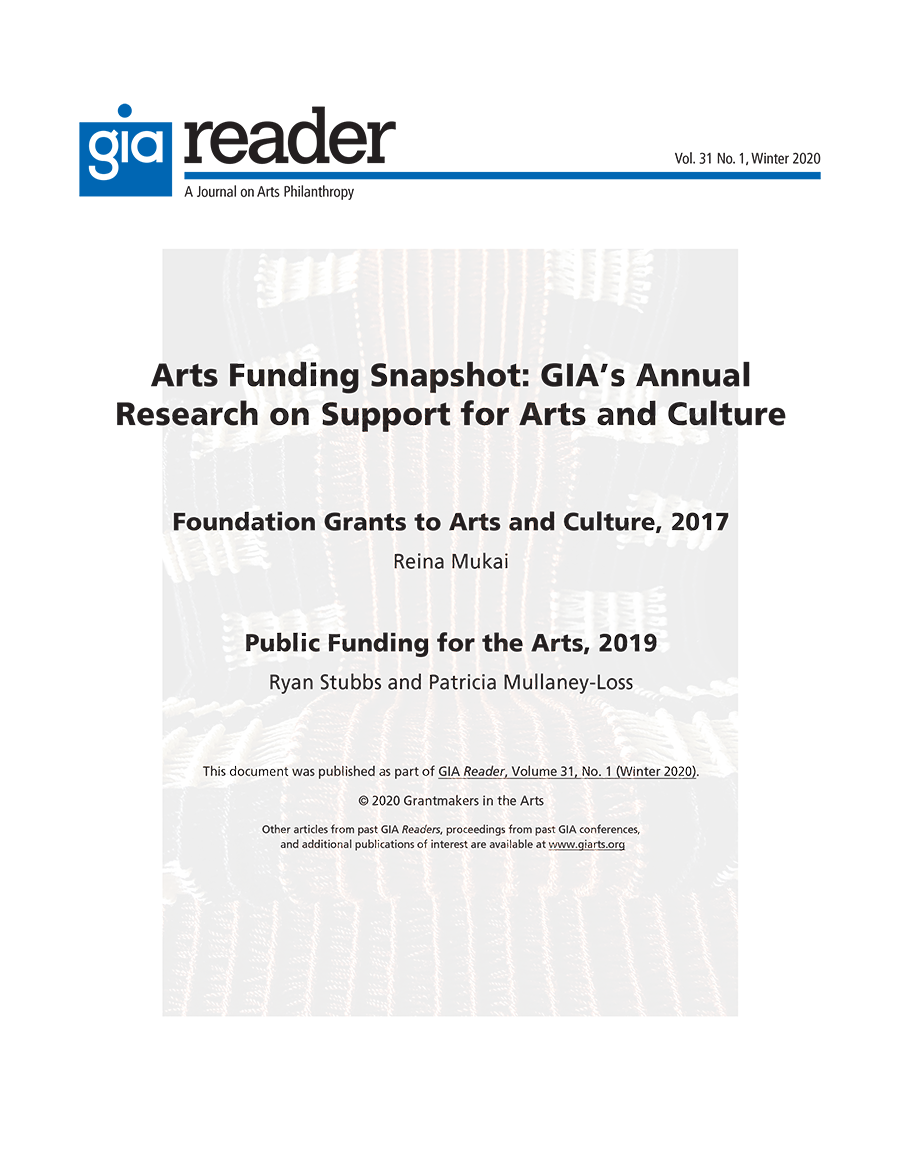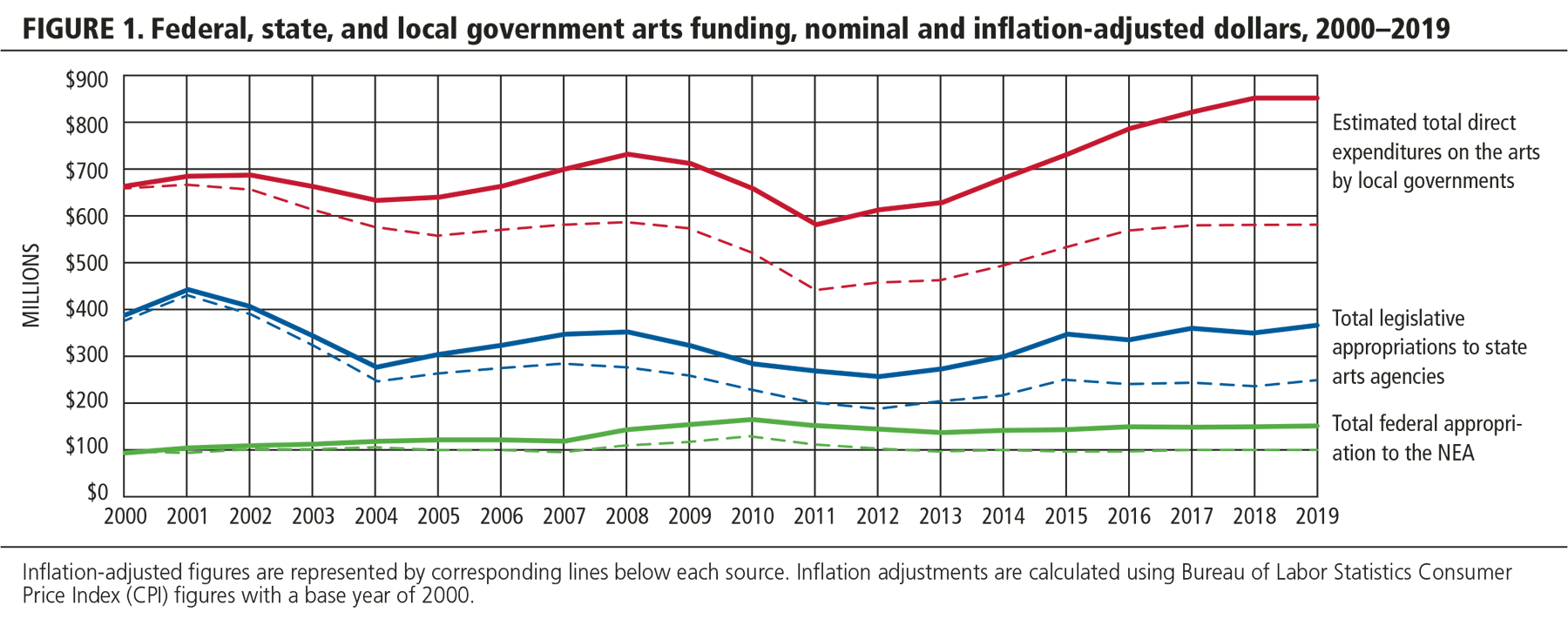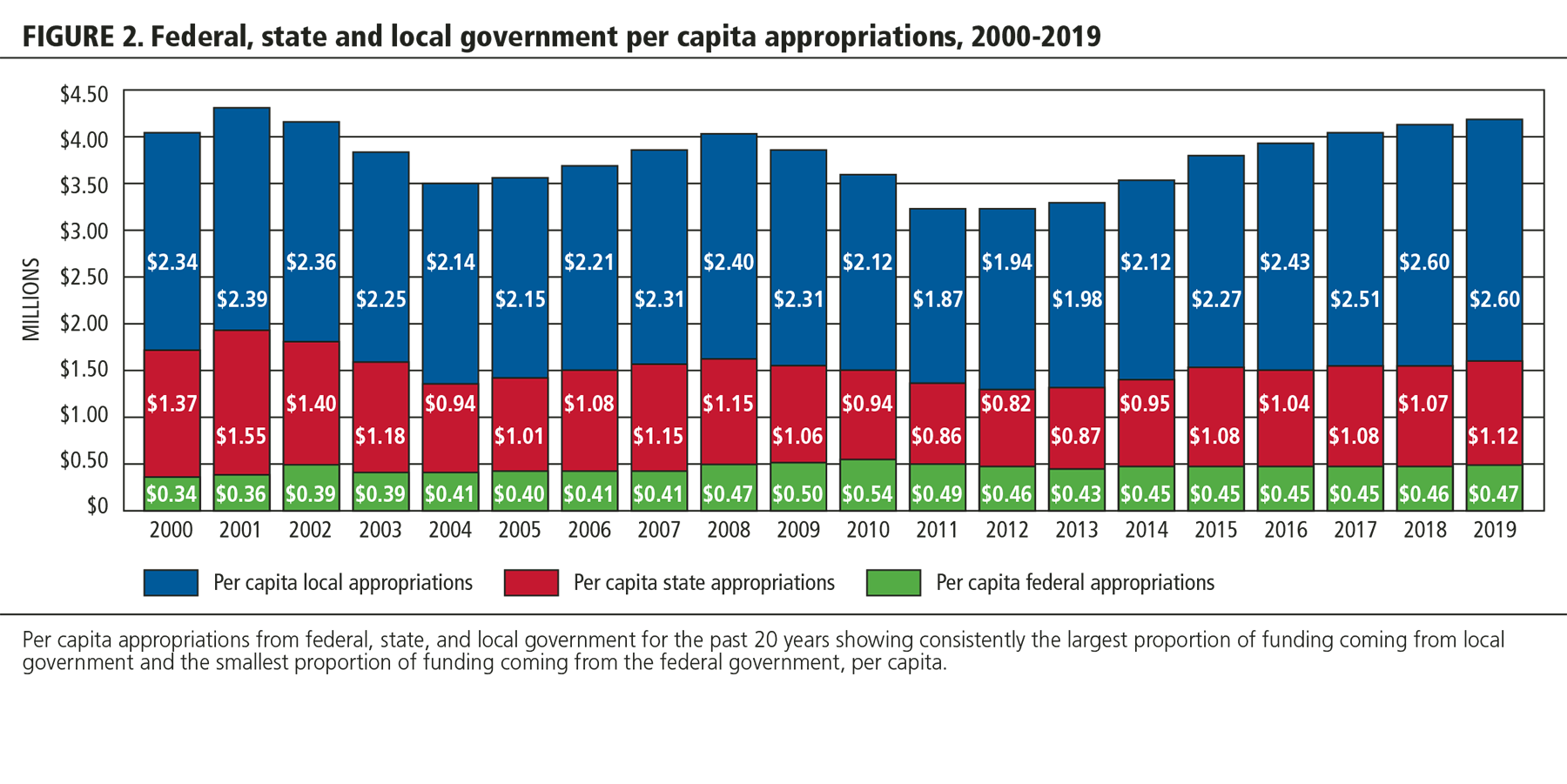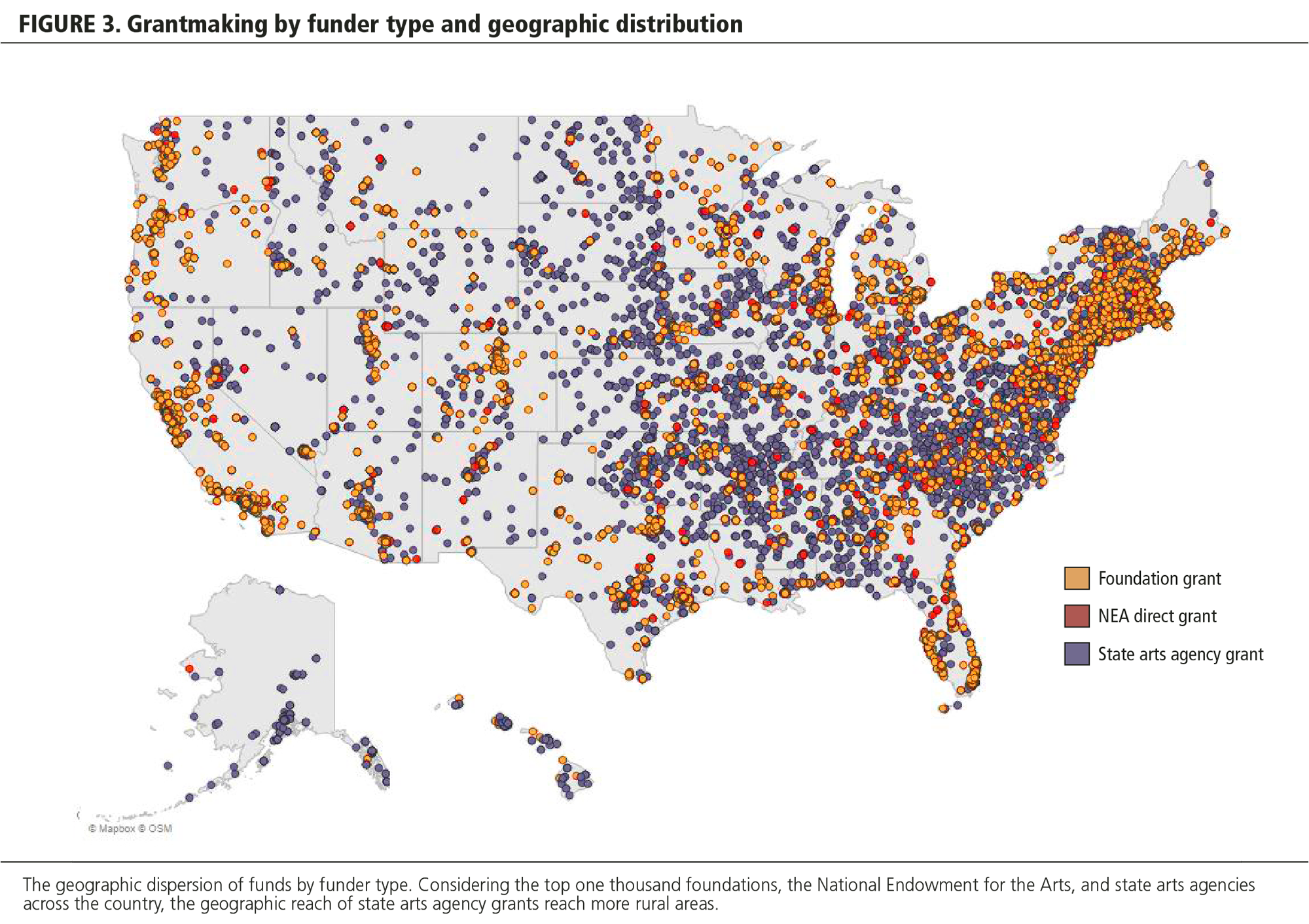City Support of the Arts by Ranking Investment Budget

Download:
![]() Arts Funding Snapshot: GIA's Almanac Research on Support for Arts and Culture (2.8Kb)
Arts Funding Snapshot: GIA's Almanac Research on Support for Arts and Culture (2.8Kb)
Public funding for the arts in the United states of america comes from federal, land, and local governments. Congressional allocations to the National Endowment for the Arts (NEA), legislative appropriations to state arts agencies, and local government funds going to local arts agencies provide useful indicators of public back up for the arts and culture. Together, these agencies and organizations distribute grants and services to artists and cultural organizations across the nation.
2019 Funding Levels
In Financial Year (FY) 2019, federal, state, and local public funding for the arts totaled $1.39 billion, for a full per capita investment of $4.nineteen. Comprising this total were:
- $155 meg in appropriations to the NEA, an increase of one.four% from FY2018.
- $370.5 million in legislative appropriations to state and jurisdictional arts agencies, an increase of three.half dozen% from FY2018.
- $860.0 million in funds allocated past municipal and county governments to local arts agencies,i which remained apartment from FY2018.

Trends Over Fourth dimension
In nominal dollars (non adapted for inflation), public funding for the arts increased by almost twenty% over the past 20 years. State and local funding patterns correlate with periods of economic growth and recession. State arts agency aggregate appropriations reached a loftier point in 2001, while local funding reported a historical high signal last year. Federal funding for the NEA has displayed incremental growth later sustaining cuts during the final recession.
Despite these nominal dollar increases, public funding for the arts has non kept pace with inflation. When adjusting for aggrandizement, total public funding decreased by eighteen% over the past 20 years. In constant dollar terms, country arts agency appropriations decreased by 35%, local funding contracted past 12%, and federal funds have increased by 9%.

Serving a Growing Population
Measuring public funding relative to total population provides an important yardstick, considering that these funds originate from all taxpayers and are meant to benefit all residents. Every bit populations grow, public arts agencies demand to serve more people. Combined, federal, country, and local arts funding yielded a per capita investment of $iv.xix in 2019. Federal, state, and local funding contribute $0.47, $1.12, and $2.60 respectively. Combined per capita appropriations have been increasing since 2012, just are all the same below nominal 2001 levels. When taking inflation into consideration, total per capita appropriation equaled $2.87 in 2019. This analysis shows that the value of the dollar, combined with a growing population, increases the strain on public arts funding.
Looking Ahead
Most states are experiencing an increase in total appropriations for the arts. Based on preliminary estimates for the year ahead, state arts funding is projected to accomplish its highest level in the terminal twenty years in FY2020. Yet, appropriations to state arts agencies are constantly in flux, and mid-year changes are likely to occur.2 As well, not every state has seen this magnitude of increase. Seventeen states will likely experience flat or decreased funding for the arts in FY2020. Additionally, xx-eight states are still expected to invest less than $1.00 per capita for the arts.3
Congress has nevertheless to laissez passer a federal budget for FY2020 as of this writing. For the third yr in a row, the President recommended a complete emptying of the NEA for next twelvemonth. Nevertheless, the NEA continues to receive broad support in Congress from elected officials beyond the political spectrum, and both chambers accept recommended increases for the bureau for FY2020. Until Congress enacts the spending packet for the Department of the Interior — the upkeep beak in which the NEA is placed — continuing resolutions take kept funding for the agency at FY2019 levels.
The outlook for local arts funding is harder to project. Although local arts funding is riding at an all-time high, its growth has stalled in recent years, which mirrors the bleak budget conditions reported by many cities and counties. Overall, cities' revenue growth slowed downwards in 2018, and almost two thirds of big cities are projecting recessions as early as next yr.iv Given this context, it will be important to monitor whether local spending on the arts may experience slower growth, if not outright declines, over the next few years.
Implications for Grantmaking
As seen currently at the local level, appropriated funds to the arts and culture at all levels of government ebb and flow every bit fiscal conditions shift. Grantmaking is straight afflicted past the fluctuation of appropriations. By extension, organizations and individuals who receive grants and other forms of support from government agencies are indirectly affected by acquirement growth and fiscal stability — or the reverse.
Direct federal grants from the NEA totaled 2,239 and $59.3 million in FY2018. Some other $50.7 million from the NEA, or nigh xl% of the Endowment'due south appropriated budget, was awarded to state and regional agencies for farther grantmaking and related services. State arts agencies, using a combination of state and federal funds, awarded 23,118 grants and $315.1 million in award dollars in FY2018.
Local governments spend the almost dollars on arts and civilisation when compared to states and the NEA, but local arts agencies are less likely to focus their services on grantmaking. According to the 2018 local arts agency census from Americans for the Arts, 59% of local arts agencies operate direct grantmaking programs.5 Larger percentages of local arts agencies back up direct culture programming (85%) and manage cultural facilities (63%). 53% of local arts agencies also provide non-grant contracts to individual artists, while i third provide non-grant contracts to organizations.
Grantmaking Across Sectors
The various roles of public and private grantmaking entities allow for a multiplicity of funding priorities and agendas. There is no exact alignment when comparing grantmaking data across public and individual sectors. Additionally, local arts agencies practise not utilise standard data collection consistently beyond the county. Even so, using published data from state arts agencies, the NEA, and Candid's 2017 information on the one thousand largest foundations, there are a handful of categories for which we can guess relative investments.
Foundations and country arts agencies make pregnant grant investments in operating support. Foundations spent approximately 26% of their arts and culture grant dollars on operating support in 2017. In terms of the percentage of dollars invested, both foundations and state arts agencies make the largest commitment to operational support. 37% of state arts bureau grant dollars and 24% of all state arts bureau awards went to operational support in FY2018. The NEA's statute prohibits the agency from awarding operating support grants.
The NEA invests over $50 1000000 dollars in land arts agencies and regional arts organizations. These dollars are not operating back up for private arts organizations, but they help enable state arts agencies and local arts agencies to brand investments in operating support past increasing the total dollars agencies have available for grants and services.
Outside of operating support, information technology is possible to compare a few other grant categories and activity types. Foundations, state arts agencies, and the NEA all make investments in museums and arts education. A key dissimilarity between public and private sectors is investment in capital construction and physical infrastructure. The NEA does non provide funding for capital letter structure, and relatively few state arts agencies make grants for facilities. Foundations bear the load for funding physical cultural infrastructure in the United States.
Some other challenging topic for grantmakers is investment in individual artists and fellowships.6 The NEA makes a few select investments in individual artists through National Heritage Fellows, Jazz Masters, and Literature Fellowships, but otherwise is statutorily restricted from awarding grant funds to individual artists. Many land arts agencies devote a portion of their grants to individual artists.7 In FY2018, state arts agencies fabricated 2,647 awards to individual artists. When compared to other types of applicants, awards to individual artists were the 2nd near frequent type of accolade made by state arts agencies. Private foundations too fund individuals, only comparison data is not available.

Grantmaking by Award Size and Geographic Distribution
Like per capita calculations, analyzing award sizes and geographic distribution proves useful when assessing how public funds serve the unabridged population. The distribution of grants from publicly funded art agencies reflects the priority of geographic diverseness. In order to cover more ground with the amount of appropriations a public entity receives, many of these grants will exist small in size. To illustrate this, state arts agencies have a median award value of $five,000. Although the median award corporeality from the NEA is $20,000, 57% of all their awarded grants are less than $25,000 in size. In dissimilarity, the 1000 largest foundations award higher levels of grant dollars, the majority of which are above $25,000.
When taking a closer look at the geographic dispersion of funds, variation in grant size allows for broader distribution of grants to all corners of the U.s.a.. More than xc% of the state'southward landmass is considered rural, but merely xviii% of the population lives within those areas. Per the median grant sizes discussed to a higher place, smaller state arts agency grants ways a broader distribution of funds to smaller organizations. When mapping grants from the acme one thousand foundations, the NEA, and land arts agencies across the country, the geographic achieve of state arts bureau grants cover more rural areas.
State arts agencies honour 21% of their grants — and 17% of grant dollars — to rural areas. At the federal level, over 11% of the NEA'south grant-funded activities took place in non-metropolitan areas of the state in 2017.8 In contrast, a Usa Department of Agriculture assay found that just 5.5% of large foundations' domestic grant dollars went to rural areas.9 Individual foundation dollars to arts and culture do not reach 65% of The states counties, whereas awards from the NEA reach 779 more counties than the height one thousand private foundations.10
Government back up at the federal, state, and local levels is important for attaining access to arts and civilisation across a nation with iii.viii million square miles of land — though the cultural ecosystem requires both public and private support to thrive.11 While the private sector provides the king of beasts's share of support, public funds support different grantmaking patterns to encounter the needs of their constituencies and public mandates.
Ryan Stubbs is senior manager of enquiry at the National Assembly of Land Arts Agencies.
Patricia Mullaney-Loss is a research acquaintance at the National Assembly of Land Arts Agencies.
NOTES
- Americans for the Arts substantially inverse the methodology for collecting local arts agency investments through the local arts agency demography in 2016. Annual estimates are used prior to 2011 and subsequently 2016.
- National Association of State Upkeep Officers. Fiscal Survey of u.s.. Fall 2018. https://www.nasbo.org/mainsite/reports-data/financial-survey-of-states/fiscal-survey-athenaeum
- National Assembly of Land Arts Agencies. FY2020 State Arts Bureau Legislative Appropriations Preview. 2019, https://nasaa-arts.org/nasaa_research/fy2020-state-arts-bureau-legislative-appropriations-preview
Trend data on legislative arts funding in every land and jurisdiction tin can be found at https://nasaa-arts.org/nasaa_research/8306 - National League of Cities. City Financial Conditions 2019 Report. 2019, https://www.nlc.org/resources/city-fiscal-conditions-2019-report
- Americans for the Arts. Research Report: 2018 Profile of Local Arts Agencies; A Detailed Report about the Local Arts Agency Field in 2018. 2018, https://www.americansforthearts.org/sites/default/files/2018_LocalArt sAgencyProfile_FullReport_REVISED.pdf
- "Support for Individual Artists." Grantmakers in the Arts, Web. https://www.giarts.org/support-private-artists
- National Associates of State Arts Agencies. State Arts Bureau Support for Individual Creative person Fact Sheet. 2019, https://nasaa-arts.org/nasaa_research/indivartistgrantmakingfactsheet0316/
- National Endowment for the Arts. Appropriations Asking For Fiscal Yr 2020. 2020, https://www.arts.gov/sites/default/files/NEA-FY20-Appropriations-Asking.pdf
- Pender, John. United states of america. Department of Agronomics. Economical Inquiry Service. Foundation Giving to Rural Areas in the United States Is Dispro-portionately Low. Amber Waves, 2015. Web. https://www.ers.usda.gov/amber-waves/2015/baronial/foundation-giving-to-rural-areas-in-the-united-states-is-disproportionately-low/
- Carter, Mary Anne. "The Importance of the National Endowment for the Arts." National Council on the Arts Public Meeting. xviii Mar. 2019. https://world wide web.arts.gov/national-quango-on-the-arts/mary-anne-carter-remarks-march-2019
- Breaux, Pam. "Better Together: Public and Private Funding for the Arts." Shared Experiences Blog. The Andrew Due west. Mellon Foundation, June 2017. Spider web. https://mellon.org/resources/shared-experiences-blog/better-together-public-and-private-funding-arts/
Source: https://www.giarts.org/public-funding-arts-and-culture-2019
0 Response to "City Support of the Arts by Ranking Investment Budget"
Enviar um comentário